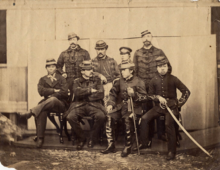Jules Brunet
Jules Brunet | |
|---|---|
General of division | |
| Battles/wars | |
| Awards |
|
Jules Brunet (2 January 1838 – 12 August 1911) was a French military officer who served the
Early life and career
Brunet was born in
Shortly after graduating, Brunet was sent to serve in the
Mission to Japan
In 1866, the French government decided to send a
The mission was composed of fifteen members, including five officers, and was led by Captain Charles Chanoine.[1] All preparations were completed on 3 November 1866, and days later the mission departed to Japan aboard the Péluse. They arrived in January 1867,[1] and trained the Shogun's troops for about a year. While in Japan, Brunet was promoted to captain (August 1867). Then the Shogun, in 1868, was overthrown in the Boshin War and Emperor Meiji was nominally restored to full power.

In late September 1868, the French military mission was ordered by its government to leave Japan. Captain Chanoine arranged for the mission to leave Japan aboard two ships, which would sail on 15 and 28 October. Brunet, however, chose to stay in Japan and remain loyal to Shogun's side of the war. He decided to assist the Ōuetsu Reppan Dōmei, known as the "Northern Alliance", in their resistance against the Imperial faction. He resigned from the French army on 4 October, informing Minister of War Adolphe Niel of his decision in a letter:[1]
"I have the honor of presenting to you my resignation from the rank of captain; I declare that from this 4 October 1868, I renounce the prerogatives of the position of artillery officer in the French army".
In another letter, to Napoleon III himself, Brunet explained the plan of the alliance, as well as his role in it:[3]
"A revolution is forcing the Military Mission to return to France. Alone I stay, alone I wish to continue, under new conditions: the results obtained by the Mission, together with the Party of the North, which is the party favorable to France in Japan. Soon a reaction will take place, and the Daimyos of the North have offered me to be its soul. I have accepted, because with the help of one thousand Japanese officers and non-commissioned officers, our students, I can direct the 50,000 men of the Confederation [...]".
On 4 October, the day of his resignation, Brunet left the French headquarters in Yokohama under the pretext of going to visit the Franco-Japanese arsenal in Yokosuka. Instead, he went to the Shogunate's fleet anchored off Shinagawa, in Tokyo Bay, where he joined André Cazeneuve, a fellow countryman who remained loyal to the Shogun.[1]
Boshin War

Brunet took an active role in the Boshin War. He and Cazeneuve were present at the
When Edo also fell to Imperial forces Enomoto and Brunet escaped, first going to
Brunet also helped to organize the Ezo army, under hybrid Franco-Japanese leadership.
Return to France and later career

Brunet and the other French advisers were wanted by the Imperial government, but were evacuated from Hokkaidō by the French corvette Coëtlogon, commanded by

After receiving a light sentence in his country
In 1879, Brunet received the promotion to
In January 1903, Brunet retired into the
Rehabilitation in Japan
Brunet's former ally, Admiral Enomoto, joined the Imperial government and became Minister of the Imperial Japanese Navy. Through Enomoto's influence, the Imperial government not only forgave Brunet's actions but awarded him medals in May 1881 and again in March 1885, among those the Order of the Rising Sun. The medals were presented at the Japanese Embassy in Paris.[9] In 1895 Brunet was made a Grand Officer of the Order of the Sacred Treasure.[1]
Cultural references
Brunet's actions served as inspiration for the character of Nathan Algren, the protagonist of the 2003 film The Last Samurai.[10][11]
Brunet also appears as a character in the 2024 video game
Drawing and paintings by Brunet
Brunet was a talented painter and sketch artist who left numerous depictions of his travels in Mexico and Japan.
-
Japanese sailors on theChōgei, 13 May 1867
-
JapaneseBakufu infantry soldier (Osaka, 29 April 1867)
-
Bakufu troops near Mount Fuji in 1867
-
Attack inLe Monde Illustré
See also
- Franco-Japanese relations
- Bakumatsu
- Naval Battle of Hakodate
Notes
- ^ .
- ^ a b c Tōhō Gakkai (Institute of Eastern Culture) (1969). "Jules Brunet, Français qui combattit à Goryōkaku". Acta Asiatica. 16–17: 59.
- ^ Soie et Lumières, l'Age d'or des échanges Franco-Japonais, p. 81 (in French and Japanese)
- ^ ISBN 978-0-19-065610-2.
- ^ ISBN 9782811107369.
- ^ a b c "M. le général Brunet". Bulletin de la Société franco-japonaise de Paris: 220. 1911.
- Institution of Royal Engineers (1871). "Visitors to the School of Military Engineering". The Royal Engineer Journal. 1.
- ^ "Nécrologie". Le Temps. 20 August 1911.
- ^ 函館の幕末・維新 p.9
- Last Samurai." Monthly Letter of the French Chamber of Commerce in Japan, p.9 "Diner des sempais en compagnie de M. Christian Polak. "Monthly Letter of the French Chamber of Commerce in Japan, p.9 "Diner des sempais en compagnie de M.Christian Polak" (PDF). Archived from the original on October 29, 2007. Retrieved 2013-09-27.)
{{cite web}}: CS1 maint: bot: original URL status unknown (link - ^ Le dernier samouraï était un capitaine français ("The Last Samurai was a French captain"), Samedi, 6 mars 2004, p. G8, Le Soleil. Quoting Christian Polak about The Last Samurai movie.
References
- ISBN 4-12-001699-4(in Japanese).
- __________. (2001). Soie et lumières: L'âge d'or des échanges franco-japonais (des origines aux années 1950). Tokyo: Chambre de Commerce et d'Industrie Française du Japon, HachetteFujin Gahōsha (アシェット婦人画報社).
- __________. (2002). 絹と光: 知られざる日仏交流100年の歴史 (江戶時代-1950年代) Kinu to hikariō: shirarezaru Nichi-Futsu kōryū 100-nen no rekishi (Edo jidai-1950-nendai). Tokyo: Ashetto Fujin Gahōsha, 2002. OCLC 50875162




